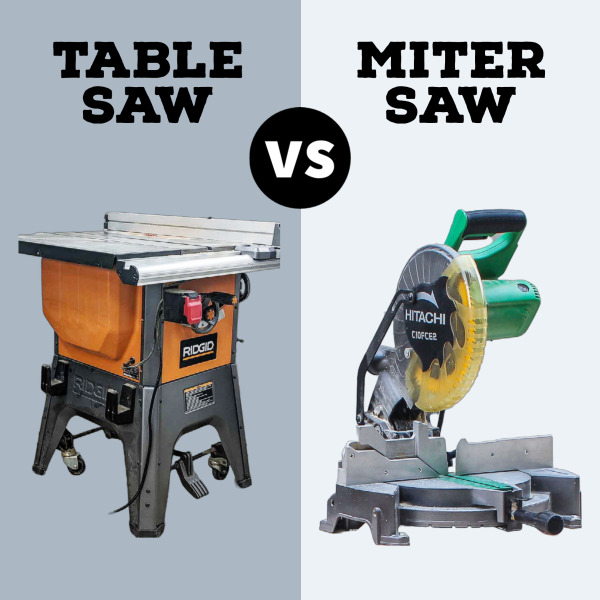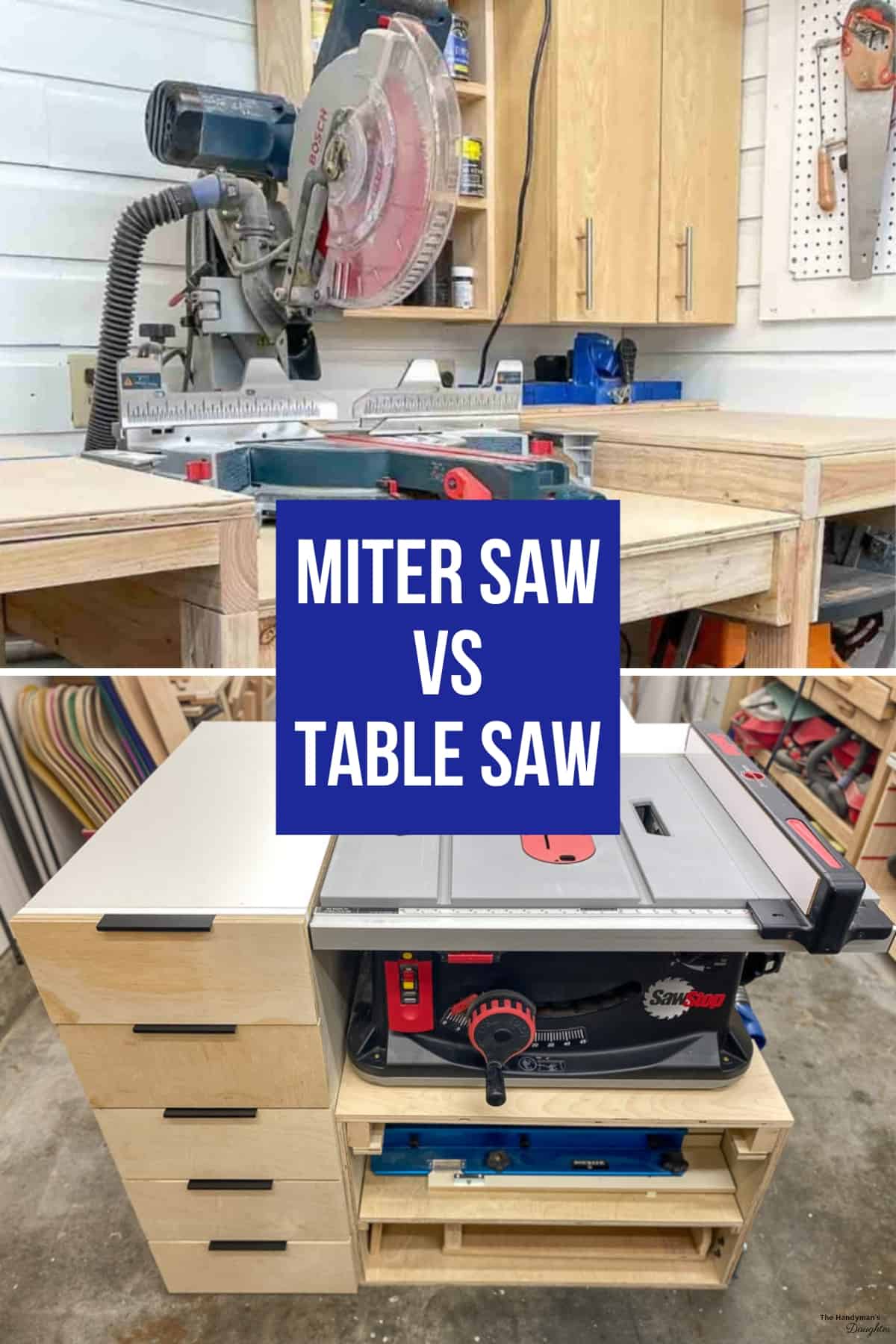Are you wondering if you need a miter saw when you already have a table saw? Well, let’s dig into this woodworking dilemma together! 🪚💡
Picture this: you’re in your workshop, ready to tackle your latest project. You have your trusty table saw, but then the question arises: do you need a miter saw too? 🤔
Don’t worry, my curious friend! In this article, we’ll explore the differences between these two power tools and help you figure out if you really need both in your arsenal. Let’s get sawing! 💪🛠️
If you have a table saw, you may wonder if you need a miter saw. While a table saw can handle many cutting tasks, a miter saw offers unique capabilities. Here are a few reasons why you might need a miter saw in addition to your table saw:
- More precise angle cuts: Miter saws excel at making angled cuts with accuracy.
- Easy crosscuts: Miter saws make crosscuts faster and easier than a table saw.
- Versatility: Miter saws can handle a wider range of cutting tasks, including bevel cuts and compound cuts.
- Portability: Miter saws are often more portable and can be moved to different job sites.
- Efficiency: Having both a miter saw and a table saw allows you to work more efficiently and tackle a variety of projects.
While a table saw is a valuable tool, a miter saw can enhance your woodworking capabilities and provide more versatility.

Do You Need a Miter Saw if You Have a Table Saw?
In the world of woodworking, having the right tools can make a world of difference in the quality and efficiency of your projects. Two essential tools commonly found in a woodworker’s arsenal are the miter saw and the table saw. While both serve different purposes, there may be some overlap in their functionalities, leading to the question: do you really need a miter saw if you already have a table saw? Let’s explore this dilemma and discover the pros and cons of each tool to determine if you truly need both.
The Miter Saw: A Versatile Cutting Machine
The miter saw, also known as a chop saw, is a specialized tool designed for making accurate crosscuts and miters in wood and other materials. Its main distinguishing feature is the ability to tilt and rotate the blade to create beveled and compound angle cuts, making it highly versatile for various woodworking projects.
One of the primary advantages of a miter saw is its precision in crosscutting and mitering. It allows you to make clean, accurate cuts at precise angles, making it ideal for projects that require precise measurements, such as creating frames, trim work, or crown molding. With its adjustable angle and depth stop features, a miter saw can easily produce consistent cuts, ensuring a professional finish.
Another benefit of a miter saw is its portability and ease of use. Most miter saws are compact and lightweight, making them easy to transport and set up in different locations. Its simple operation and intuitive controls make it accessible for woodworkers of all skill levels.
The Table Saw: The Workhorse of the Woodshop
If the miter saw is the precision cutting tool, then the table saw is the workhorse that handles a wide range of cutting tasks. A table saw consists of a circular blade mounted on an arbor that protrudes through the surface of a flat table. It is primarily used for ripping boards, cutting large sheet goods, and creating clean, straight cuts.
One of the standout features of a table saw is its ability to handle heavy-duty cutting tasks. With its powerful motor and stable work surface, it can effortlessly cut through thick hardwoods, plywood, and other materials. This makes it a must-have for larger projects like building furniture, constructing cabinets, or tackling large-scale renovations.
An advantage of a table saw is its ability to make repeatable cuts. It is equipped with rip fences, miter gauges, and other accessories that allow you to make consistent cuts time and time again. This is especially helpful in situations where you have multiple identical pieces to cut.
The Benefits of Owning Both a Miter Saw and a Table Saw
If you’re serious about woodworking and have the means to invest in both a miter saw and a table saw, the benefits of having both of these tools in your workshop are substantial. Each tool has its own unique strengths and functionalities that, when combined, offer the woodworker unparalleled versatility and precision.
Having a miter saw and a table saw essentially covers all the bases when it comes to cutting tasks. With a miter saw, you can effortlessly create perfect mitered corners, beveled edges, and compound angle cuts. It excels at crosscutting and working with smaller pieces. On the other hand, a table saw is indispensable for ripping large boards, cutting sheet goods, and working with longer pieces of wood. Its precise rip fence and cutting capabilities make it the go-to tool for larger and more intricate projects.
By having both tools at your disposal, you can take on a wider range of projects and achieve professional-grade results with ease. It eliminates the need for workarounds or compromising on the quality of your cuts. Whether you’re working on intricate trim work or building a custom piece of furniture, the combination of a miter saw and a table saw ensures you have all the tools necessary to bring your ideas to life.
The Verdict: Do You Need Both?
While it is possible to accomplish many woodworking tasks with just one of these tools, owning both a miter saw and a table saw greatly expands your capabilities and opens up new possibilities in your woodworking projects. The miter saw’s precision and versatility complement the table saw’s raw cutting power and stability. Together, they provide you with the best of both worlds, allowing you to make intricate cuts, crosscuts, and rip cuts with ease.
Investing in both a miter saw and a table saw creates a well-rounded woodshop that can handle a wide range of projects. Whether you’re a hobbyist or a professional woodworker, having these essential tools in your arsenal ensures you have the versatility and precision needed to bring your woodworking dreams to life.
Key Takeaways: Do You Need a Miter Saw If You Have a Table Saw?
- 1. A miter saw and a table saw serve different purposes in woodworking.
- 2. A miter saw is great for making angled or beveled cuts, while a table saw excels at straight cuts.
- 3. If you frequently need to make precise angled cuts for projects like trim or molding, a miter saw is a valuable tool to have.
- 4. However, if you primarily work on projects that require straight cuts or ripping wood, a table saw can be sufficient.
- 5. Ultimately, having both tools in your workshop can offer maximum versatility and efficiency for various woodworking tasks.
Frequently Asked Questions
Are you wondering if you need a miter saw when you already have a table saw? We’ve got the answers to your questions right here.
1. What are the main differences between a miter saw and a table saw?
A miter saw is primarily used for making crosscuts at various angles, while a table saw is designed for ripping long boards or making straight cuts. The miter saw has a pivoting arm that allows you to rotate the blade to make angled cuts, whereas the table saw has a fixed blade that moves up and down through a table’s surface.
In summary, a miter saw is great for precise angled cuts, whereas a table saw is more versatile and ideal for ripping and making straight cuts.
2. Can I use a table saw instead of a miter saw?
Yes, a table saw can be used to make crosscuts, so you can technically accomplish similar tasks. However, a miter saw provides more accuracy and control for angled cuts, especially when making miter joints or picture frames. The miter saw’s pivoting arm and adjustable angle settings make it easier to achieve the desired cuts compared to a table saw.
If you only need to make a few angled cuts here and there, using a sled or a miter gauge on a table saw might suffice. However, if you frequently work with angled cuts, investing in a miter saw would be a wise choice.
3. Do I need both a table saw and a miter saw in my workshop?
It depends on the type of work you do. If you often make straight cuts or rip long boards, a table saw would be the more essential tool to have. On the other hand, if you frequently work on projects that require angled cuts, a miter saw would be a valuable addition to your workshop.
If budget or space is a constraint, some woodworkers opt for a compound miter saw, which combines the capabilities of both a miter saw and a table saw in one tool. However, keep in mind that a compound miter saw may not offer the same level of precision and power as separate specialized tools.
4. Are there any safety considerations when using a miter saw or a table saw?
Absolutely! Both tools have their own safety guidelines that should be strictly followed. When using a miter saw, always ensure the workpiece is securely clamped and that your hands are at a safe distance from the blade. Additionally, using a miter saw with a blade guard and a dust collection system is highly recommended to minimize the risk of accidents.
Similarly, when using a table saw, safety features like a blade guard, riving knife, and a good push stick should never be neglected. It’s crucial to read the manufacturer’s instruction manual and follow proper safety procedures to avoid injuries while operating these powerful tools.
5. Can I accomplish all woodworking tasks with either a miter saw or a table saw?
While a miter saw and a table saw are versatile tools, there may be certain woodworking tasks that require specialized tools. For example, if you need to cut intricate shapes or curves, a scroll saw or a jigsaw would be more suitable. Similarly, for joinery tasks like dovetails or box joints, a router table or a dovetail jig would provide better results.
Ultimately, the choice of tools depends on your specific projects and the level of precision required. Having a mix of different tools in your workshop allows you to tackle a wider range of woodworking tasks and achieve the best results.

Do you need a miter saw? | Mere Mini
Summary
So, do you really need a miter saw if you already have a table saw? Well, it depends on what you plan to do. If you mainly work on straight cuts, the table saw should be enough. But if you want to make angled cuts or mitered corners, a miter saw can be really handy. It offers more flexibility and accuracy for these types of cuts. Plus, it’s easier to set up and safer for certain tasks. So, while a table saw is a great tool to have, a miter saw can be a valuable addition to your workshop.
In conclusion, having both a table saw and a miter saw gives you the best of both worlds. Each tool has its own strengths and they complement each other well. So, if woodworking is a serious hobby or profession for you, investing in both can greatly expand your capabilities and help you achieve more precise and versatile cuts.
